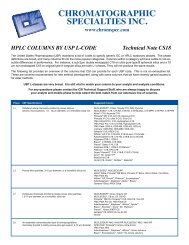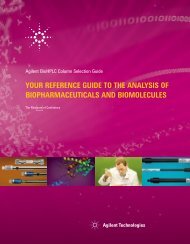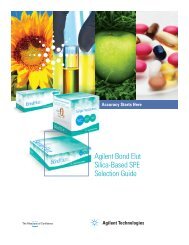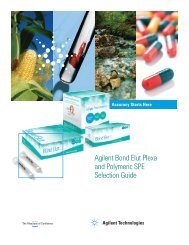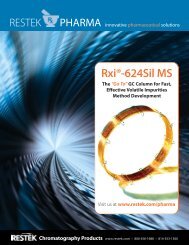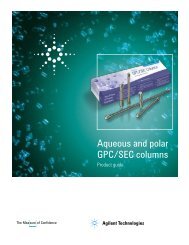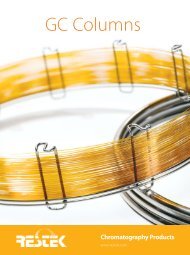Optimizing the Analysis of Volatile Organic Compounds
Optimizing the Analysis of Volatile Organic Compounds
Optimizing the Analysis of Volatile Organic Compounds
Create successful ePaper yourself
Turn your PDF publications into a flip-book with our unique Google optimized e-Paper software.
4<br />
Drinking Water Disinfection Byproducts<br />
1996 amendments to <strong>the</strong> SDWA require <strong>the</strong><br />
EPA to review and revise existing National<br />
Primary Drinking Water Regulations<br />
(NPDWR) at least once every six years. Much<br />
<strong>of</strong> this renewed interest in changes to drinking<br />
water regulation standards stems from<br />
studies suggesting negative reproductive<br />
effects, such as spontaneous abortions,<br />
resulting from trihalomethanes (THMs) in<br />
water. Current studies using compliant levels<br />
<strong>of</strong> THMs in water have revealed adverse<br />
reproductive effects, <strong>the</strong>refore method detection<br />
limits (MDLs) will continue to be lowered<br />
in methods that address THMs. 1<br />
1. S. Richardson, Anal. Chem. 73 (2001)<br />
2719-2734.<br />
www.restekcorp.com<br />
Hazardous Waste Methods (8000 Series)<br />
The Resource Conservation and Recovery Act (RCRA) <strong>of</strong> 1976 was enforced shortly after<br />
front-page headlines revealed <strong>the</strong> presence <strong>of</strong> serious hazardous waste sites like Love Canal,<br />
NY and Times Beach, MO. The analytical methods for determining hazardous waste, known<br />
as <strong>the</strong> 8000 series methods, fall under US EPA SW-846. These methods were designed for<br />
monitoring organic pollutants in waste samples prior to disposal at hazardous waste facilities.<br />
They also can be used for monitoring groundwater at <strong>the</strong>se facilities.<br />
Method 8010B: This packed column GC method is used to monitor 50 halogenated volatile<br />
pollutants in hazardous waste samples. It employs purge and trap concentration and an<br />
ELCD.<br />
Method 8011: This capillary column GC method is used to monitor 1,2-dibromoethane<br />
(EDB) and 1,2-dibromo-3-chloropropane (DBCP) in hazardous waste samples. It employs<br />
microextraction, using hexane, and analysis using an ECD.<br />
Method 8015A: This packed column GC method is used to monitor non-halogenated<br />
volatile pollutants in hazardous waste samples. It employs purge and trap concentration and<br />
an FID. Total petroleum hydrocarbon analysis, commonly refered to as 8015-TPH, also falls<br />
under this method. Method 8015-TPH uses an FID to match a known pattern <strong>of</strong> gasoline<br />
with an unknown sample containing peaks that fall within <strong>the</strong> gasoline pattern range. If a<br />
pattern falls within <strong>the</strong> gasoline window it may be reported as gasoline.<br />
Method 8020A: This packed column GC method is used to monitor ten aromatic volatile<br />
pollutants in hazardous waste samples. It employs purge and trap concentration and a PID. It<br />
is common for analysts to combine Methods 8010 and 8020, by using a PID and an ELCD<br />
in series.<br />
Method 8021A: This capillary column GC method is used to monitor 60 volatile contaminants<br />
in hazardous waste samples. It employs purge and trap concentration, combined with a<br />
PID and an ELCD in series. The PID detects aromatic compounds and double-bond compounds,<br />
and <strong>the</strong> ELCD detects halogenated compounds.<br />
Method 8021B: Using <strong>the</strong> same analytical technique as Method 8021A, <strong>the</strong> compound list<br />
for Method 8021B includes ten additional compounds but does not require <strong>the</strong> analysis <strong>of</strong><br />
several branched aromatics and halogenated compounds.<br />
Method 8240B: This packed column GC/MS method is used to monitor 79 volatile pollutants<br />
in hazardous waste samples. It employs purge and trap concentration for most analytes,<br />
but direct injection can be used for some limited applications.<br />
Method 8260B: This capillary column GC/MS method is used to monitor 98 volatile pollutants<br />
in hazardous waste samples. It employs purge and trap concentration for most analytes,<br />
but direct injection can be used for some limited applications.<br />
State GRO Methods<br />
Leaking underground storage tanks (LUST) pose significant environmental risks throughout <strong>the</strong><br />
country. States have <strong>the</strong> responsibility to develop LUST testing methods. State gasoline range<br />
organics (GRO) methods are based on EPA methods such as 602, 8020 and 8015. The most<br />
common EPA method used is 8015, which relies on baseline-integrating <strong>the</strong> total area <strong>of</strong> <strong>the</strong><br />
gasoline fingerprint, using marker compounds such as hexane (C6) and dodecane (C12). The<br />
8015-TPH Method analysis uses an FID and pattern recognition—<strong>the</strong> specific ratio <strong>of</strong> peaks<br />
that make up a particular fuel—to identify <strong>the</strong> type <strong>of</strong> fuel. If a pattern falls within <strong>the</strong> window<br />
markers it may be reported as gasoline, <strong>the</strong>n quantified. Difficult matrices can result in misidentification<br />
or poor quantitation <strong>of</strong> <strong>the</strong> sample, and deterioration in <strong>the</strong> environment (wea<strong>the</strong>ring)<br />
fur<strong>the</strong>r complicates <strong>the</strong> analysis. Therefore, many states have combined EPA methods, using a<br />
PID/FID in series (e.g., Methods 8020/8015-TPH). Specific aromatic compounds are analyzed<br />
using PID (Methods 602, 8020), which is connected to <strong>the</strong> FID (Method 8015-TPH). The common<br />
target compounds are benzene, toluene, ethylbenzene, and m-, o-, and p-xylene (BTEX),<br />
however many states also have added o<strong>the</strong>r compounds to <strong>the</strong>ir methods (Table I).





